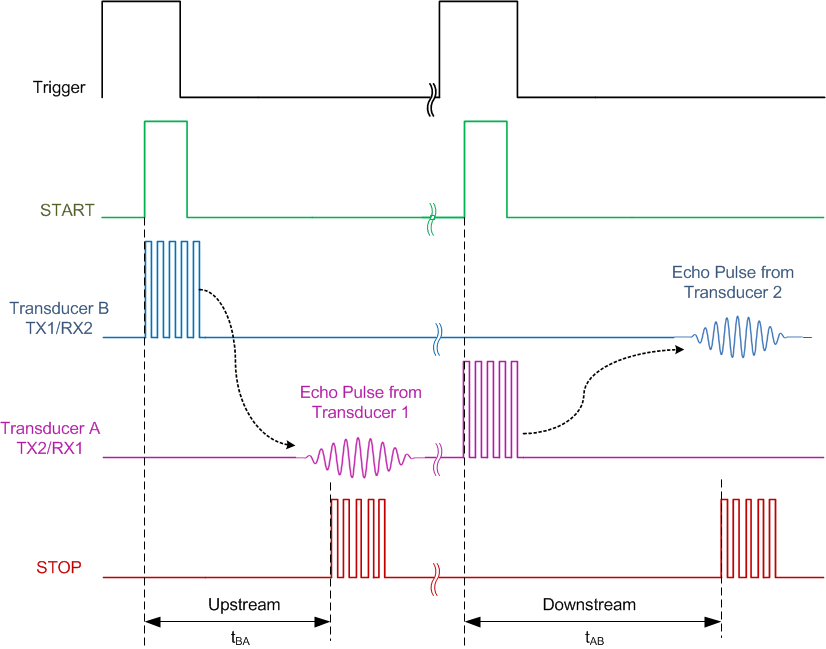SNAS854 February 2023 TDC1000-Q1
PRODUCTION DATA
- 1 Features
- 2 Applications
- 3 Description
- 4 Revision History
- 5 Pin Configuration and Functions
- 6 Specifications
- 7 Parameter Measurement Information
-
8 Detailed Description
- 8.1 Overview
- 8.2 Functional Block Diagram
- 8.3 Feature Description
- 8.4 Device Functional Modes
- 8.5 Programming
- 8.6 Register Maps
- 9 Application and Implementation
- 10Device and Documentation Support
- 11Mechanical, Packaging, and Orderable Information
9.2.2.2.2 Transit-Time in Ultrasonic Flow Meters
Transit-time ultrasonic flow meters works based on the principle that sound waves in a moving fluid travel faster in the direction of flow (downstream), and slower in the opposite direction of flow (upstream).
The system requires at least two transducers. The first transducer operates as a transmitter during the upstream cycle and as a receiver during the downstream cycle, and the second transducer operates as a receiver during the upstream cycle and as a transmitter during the downstream cycle. An ultrasonic flow meter operates by alternating transmit and receive cycles between the pair of transducers and accurately measuring the time-of-flight both directions.
 Figure 9-8 Relation Between Transmit and Receive Pulses Upstream/Downstream
Figure 9-8 Relation Between Transmit and Receive Pulses Upstream/DownstreamIn this example, the upstream TOF is defined as:

where
- l is the path length between the two transducers in meters (m)
- c is the speed of sound in water in meters per second (m/s)
- v is the velocity of the water in the pipe in meters per second (m/s)
In this example, the downstream TOF is defined as:

where
- l is the path length between the two transducers in meters (m)
- c is the speed of sound in water in meters per second (m/s)
- v is the velocity of the water in the pipe in meters per second (m/s)
The difference of TOF is defined as:

where
- tBA is the upstream TOF from transducer B to transducer A in seconds (s)
- tAB is the downstream TOF from transducer A to transducer B in seconds (s)
After the difference in time-of-flight (ΔTOF) is calculated, the water velocity inside the pipe can be related to the ΔTOF using the following equation:

where
- c is the speed of sound in water in meters per second (m/s)
- l is the path length between the two transducers in meters (m)
Finally, the mass flow rate can be calculated as follows:

where
- k is the flow meter constant
- v is the velocity of the water in the pipe in meters per second (m/s)
- A is the cross-section area of the pipe in meters-squared (m2)